Candlestick Analysis Course For Binary Options
Contents ▾
- Japanese Candlestick Charts Explained
- Best Brokers For Candlestick Charts:
- Candlestick Patterns
- Doji
- Strategy Basics
- Interpreting Tails
- The Hammer
- The Gravestone
- Tails, Wicks And Shadows
- Doji Strategy for Binary Options
- Breakout Strategy – Setup A Robot
- Doji Patterns – Conclusions
- Nautical chart Patterns Explained
- Candlestick Analysis – Examples
- Moving Averages
- Volume
- Reading Charts – Closing Guide
Candlestick charts are perhaps the most popular trading chart. With a wealth of data hidden inside each candle, the patterns form the basis for many a merchandise or trading strategy.
Here nosotros explain the candlestick and each element of the candle itself. Then we explicate common candlestick patterns like the doji, hammer and gravestone. Beyond that, we explore some of the strategy, and chart analysis with short tutorials. Reading candlestick charts provides a solid foundation for technical assay and winning binary options strategy.
Japanese Candlestick Charts Explained
Japanese Candlesticks are one of the most widely used chart types. The charts show a lot of information, and do and then in a highly visual way, making information technology easy for traders to see potential trading signals or trends and perform analysis with greater speed. So permit the states explain what Japanese Candlesticks are, how the "candles" are created and basic candlestick interpretation.
It'south a fact that many novice traders, new to the trading manufacture, focus on candlesticks considering they are like shooting fish in a barrel to understand and give a feeling of existent trading to someone. But information technology's also a fact that nobody made money but using candlestick patterns. Many new traders are excited considering they have some skillful results in the first by candlestick patterns without spending much time reading about trading, just in the long run they neglect and they come up back to larn more than.
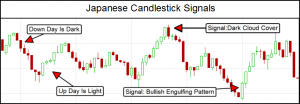
Candlestick patterns are a adept tool, just merely for confirmation. Of grade every trader should know how to read the candles. I believe this is "Lesson #1" for the new traders. If you know how to read the candles properly, you tin use them for confirmation in your trades – but first you must know the basics
Best Brokers For Candlestick Charts:
General risk warning: your capital is at risk
* Amount is credited to account in case of successful investment
Candlestick Patterns
Japanese Candlesticks are a type of nautical chart which shows the loftier, low, open and close of an assets price, as well as quickly showing whether the asset finished higher or lower over a specific period, by creating an easy to read, unproblematic, estimation of the market. Candlesticks tin be used for all time frames – from a 1 minute chart right upward to weekly and yearly charts, and take a long and rich history dating dorsum to the feudal rice markets of aboriginal Samurai dominated Nippon. When information is presented in such a mode, it makes it relatively easy – compared to other forms of charts – to perform analysis and spot merchandise signals.
To understand how this works, we'll need to await at how each bar is constructed. As indicated, each candle provides information on the open, close, high and low of an avails price. Each reflects the time period you have selected for your chart. For case, if a 5 minute chart was used each candle shows the open, close, high and low cost information for a 5 minute period. When 5 minutes has elapsed a new 5 minute candle starts.
The same process occurs whether yous apply a i infinitesimal chart or a weekly chart.The open and close are marked by the "fat" part of the candlestick. This is chosen the real torso, and represents the divergence betwixt the open and close. If the close is higher than the open, the candle will be dark-green or white; if the close is lower than open up the bar will be scarlet or black but other colors can ofttimes be establish on different charts.
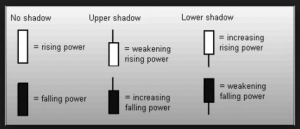
The open or close are not necessarily the high or low cost points of the period though. The loftier and low prices for the period are marked by a "wick" or "upper shadow" and "lower shadow." The high bespeak of the upper shadow gives the highest toll the asset went during that period, and the depression point of the lower shadow gives the lowest toll the asset went during that flow.
Doji
If there are no upper or lower shadow it means the open and close were likewise the high and low for that catamenia which in itself is a kind of betoken of marketplace strength and direction. Occasionally you volition too see bars that are about all upper and/or lower shadow, with very little real body. These are chosen dojis and have special pregnant, a market in balance, and often requite strong signals.
Strategy Nuts
Due to the highly visual structure of candlesticks there are many signals and patterns which traders use for assay and to establish trades. Some patterns volition be classed as 'avant-garde strategies', simply in that location are general principles that those new to Japanese Candlestick charts should empathize. Hither are a few, I'll go into more particular on some of these ideas further along in this discussion.
- A long real torso indicates stronger pressure than a small-scale existent torso. For example, a long dark-green trunk represents stronger buying force per unit area than a small green trunk. A long ruby-red torso represents stronger selling pressure than a small red trunk.
- Shadows can be used to decide what group of traders–buyers or sellers–was strongest at the close of a candle. While not ever, it is quite possible that the strongest group at the close of the prior bar will be strongest heading into the next bar.
- A long lower shadow with very trivial upper shadow indicates sellers tried to push the price downwardly, just ultimately the buyers succeeded in pushing the price support and were strong at the close.
- A long upper shadow with very little lower shadow indicates buyers tried to push button the price up, but ultimately the sellers succeeded in pushing the price dorsum downward and were strong at the close.
Interpreting Tails
What many traders fail to pay attending to is the tails or wicks of a candle. They mark the highs and lows in price which occurred over the toll catamenia, and show where the toll closed in relation to the loftier and low. During an boilerplate 24-hour interval of trading upper and lower shadows are commonly formed, and they don't really mean that much. But on some days, as when the toll is trading well-nigh back up or resistance levels, or forth a trend line, or during a news event, a strong shadow may form and create a trading bespeak of existent importance.
If there is ane thing that everyone should remember nearly the candle wicks, shadows and tails is that they are fantastic indications of support, resistance and potential turning points in the market. To illustrate this betoken lets look at two very specific candle signals that incorporate long upper or lower shadows.
The Hammer
The hammer is a candle that has a long lower tail and a pocket-size body near the tiptop of the candle. It shows that during that menstruation (whether ane minute, 5 minute or daily candlesticks) that price opened and fell quite a distance, merely rallied back to close nearly (above or beneath) the open. This is sign that buyers stepped into a weak market and are "hammering out a lesser."
Long lower tails are seen all over the place, and aren't significant on their own. But they are pregnant when a long lower tail–hammer–is seen almost support. It indicates the sellers tried to push button the price through back up just failed, and at present the buyers are likely to take price higher again. The matter to think hither is that a hammer could indicate a new area of support as well.
Figure i shows an example of a hammer candle on the USDJPY Daily Chart.
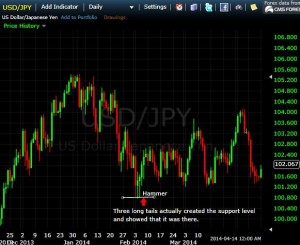
Three candles, all with long tails occurred in the same cost area and had very like price lows. That three long tailed candles all respected the aforementioned area showed at that place was strong support at 100.800. When the hammer occurred (tertiary candle in the series with the red expanse below it) information technology showed that toll was probable to continue higher, since sellers had tried to push the price lower, but couldn't.
The Gravestone
The gravestone (or 'tombstone') is a candle that has a long upper tail and a small torso near the bottom of the candle, opposite of the hammer. It shows that during the menses (whether 1 minute, 5 minute or daily candlesticks) that price opened then rallied quite a altitude, but so roughshod to close near (in a higher place or below) the open. This is sign that sellers stepped into a hot market and created a graveyard for the buyers.
Long upper tails are seen all over the place, and are not meaning on their own. But they are significant when a long upper tail–gravestone–is seen near resistance, unless of class a new resistance level is existence ready. Information technology indicates the buyers tried to push the toll through resistance but failed, and at present the sellers are likely to accept price lower again.
Figure two shows an example of a gravestone candle on the EURUSD hourly chart.
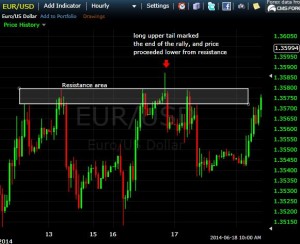
The price tested this resistance expanse multiple times, finally it broke above information technology, but within the same bar (one 60 minutes) the price collapsed back. This indicated the buyers didn't accept control and that the breakout would likely fail. The cost did proceed lower from there.
Tails, Wicks And Shadows
Look for them on candles, they are important. Multiple long tails in i area, similar in figure 1, show at that place is a back up or resistance there. If a hammer or gravestone candle occurs near support or resistance, look a reversal since the support/resistance has held. A hammer opens and closes near the pinnacle of the candle, and has a long lower tail. A gravestone opens and closes near the bottom of the candle, and has a long upper tail. By themselves they can give shady signals so beware, when used with other analysis like support/resistance, stochastic, MACD, trend line etc are a very powerful tool of the modern trader. The adjacent thing to look out for is the doji, a candle that combines traits of the hammer and gravestone into one powerful signal.
Doji Strategy for Binary Options
Dojis are among the near powerful candlestick signals, if y'all are non using them you lot should be. Candlesticks are by far the best method of charting for binary options and of the many signals derived from candlestick charting dojis are among the about pop and easy to spot.
There are several types of dojis to be aware of only they all share a few common traits. First, they are candles with little to no visible trunk, that is, the open and closing price of that sessions trading are equal or very, very close together. Dojis likewise tend to have pronounced shadows, either upper or lower or both. These traits combine to requite deep insight into the market and can show times of balance as well as extremes. In terms of signals they are pretty accurate at pinpointing marketplace reversals, provided you read them correctly.
Similar all signals, doji candles can appear at whatever time for just about any reason. All they really signify is a residuum of today's traders; if buyers and sellers are in balance during a session cost action will remain stable. It takes other factors to give the doji true importance such equally book, size and position relative to technical price levels. Truly of import dojis are rarer than nigh candle signals but also more reliable to merchandise on. Hither are some things to consider.
Get-go, how big is the doji. If it is relatively small, equally in it has short upper and lower shadows, it may exist cypher more than a spinning meridian style candle and representative of a drifting market and ane without direction. If withal the doji shadows encompass a range larger than normal the force of the bespeak increases, and increases relative to the size of the doji. Candles with extremely large shadows are called long legged dojis and are the strongest of all doji signals.
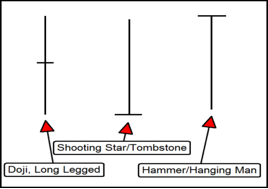
2nd is where the doji appears; does it appear at a support or resistance line or is information technology floating in a no man's land between two back up/resistance targets. If it is not almost a support/resistance line the bespeak is much weaker than if it is confirming a back up or resistance. In fact, if the shadow, either upper or lower, crosses one of these lines and so closes to a higher place/below information technology the signal is quite strong indeed.
I of this type appearing at support may exist a meteor, pivot bar or hanging homo signal; i occurring at support may be a tombstone or a hammer indicate. Expect at the example beneath. At that place are numerous candles that fit the bones definition of a doji just just ane stands out every bit a valid betoken. This doji is long legged, appears at support and closes above that support level.
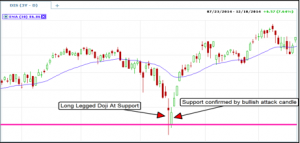
Some other confirming indication that a doji is a potent betoken and not a fake ane is volume. The higher the volume the better as it is an indication of marketplace delivery. In respect to the in a higher place example it means that price has corrected to an extreme, and at that farthermost buyers stepped in. It likewise means that well-nigh term sellers have disappeared, or all those who wanted to sell are now out of the market place, leaving the road clear for bullish price action.
Doji's can be trend post-obit or betoken reversals then that must be considered as well. A doji confirming back up during a clear uptrend is a trend following signal while one occurring at a peak during the same trend may indicate a correction. The same is true for down trends. Failing to account for tendency, or range spring conditions, can be the difference between a assisting entry or non.
Breakout Strategy – Setup A Robot
The beneath demo video, explains how to configure a robot using the builder feature at IQ Option. The video explain how to specifically setup a strategy based on candlesticks, and doji patterns within them;
Doji Patterns – Conclusions
While doji'southward can be fantastic signals for binary options they should exist considered a signal to look for entry, and not as an entry itself. In the example above a telephone call pick is clearly the correct matter to do but if purchased at the close of the doji, it could hands have resulted in a loss. The doji shows support like sonar shows the bottom of the body of water but that does not mean a reversal will happen immediately. The best thing to do is to wait for at least the next candle and target an entry shut to support. This same is true for resistance every bit well.
Doji'southward are also fine to utilise in whatsoever fourth dimension frame but remember the rules. When changing time frames add this; the doji'south size and analysis is relative to other doji's and candles in that time frame. A long legged doji doesn't mean the aforementioned thing if they appear frequently on the charts unless it is significantly larger the average long legged doji.
Expiry will exist your final business organization. If entry is taken very close to the targeted support/resistance level a one or two bar expiry is virtually likely all you lot volition need but information technology may exist prudent to extend that out to five bars just to make sure.
Nautical chart Patterns Explained
Accept you ever heard the maxim, "can't see the forest for the trees"? This is a very apt saying that simply means getting caught up in the minor things and non seeing the bigger moving picture. This tin can happen all to frequently when trading and is especially common among newer traders. This can happen in a number of means such as too many indicators, paying too much attention to small-scale day to day fluctuations or in the case of today's discussion, paying to much attention to your Japanese Candlesticks. Candlesticks, and candlestick charting, are one of the peak methods of analyzing financial charts merely like all indicators can provide just every bit many bad or imitation signals every bit it does good ones. For that reason alone it is a skilful idea to filter whatsoever candle signal with another indicator or assay.
I'm going to assume that you already know something about candles because you are this deep into the article already. I like them considering they offer so much more insight into price activeness. Switching from a line chart to an O-H-Fifty-C chart to a candlestick chart is like bringing the market into focus. The candles jump off the chart and scream things like Doji, Harami and other basic price patterns that tin can alter the course of the market. The thing is, these patterns can happen everyday. Which ones are the ones you desire to use for your signals? That is the question on the listen of any one who has tried and failed to trade with this technique.
Candlestick Analysis – Examples
Expect at the chart below; a new candle forms every mean solar day. Some day a bullish candle, some days a surly one, some times two or more than days combine to form a larger pattern. Not all of them result in the "expected" movement. Expect at the chart below. I have marked 8 candle patterns widely used by traders that failed to perform as expected.
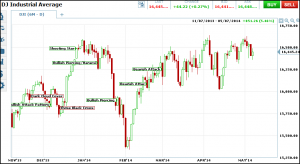
Why is this you may ask yourself? It all comes down to where the signals occur relative to by price action. When I start to add other indicators to the charts information technology may become clearer. The showtime and foremost reason is that the candle patterns I have marked practice not take any other technical or fundamental factors into account. I know that as binary traders we do not use much fundamental assay but whatsoever trader worth his salt has at least a minor grip on the underlying market conditions. After that some simple additions to the chart can help to requite some perspective and allow yous to see the forest, and not just the trees.
Time frame is ane important factor when analyzing candlesticks. The very first thing I like to practise is to literally accept a step back from my standard chart for a improve view of the market. I utilise charts of daily prices with half-dozen months or ane yr of data. To get the broadest view I tin can I use a chart with 5 or 10 years of data. The v year chart is where I draw support, resistance and trend lines that will have the most importance in my later analysis. Having an idea of where price action, and the candlesticks, are in relation to the long term trend and areas of support/resistance is crucial to estimation. A candle point occurring at or near a long term line is of far more value than i that is about a shorter term line. Yous tin use weekly confined or daily, it doesn't matter, but sometimes a really stiff candle signal will appear on the weekly charts too.
Moving Averages
Moving averages are another good way to aid weed out bad candlestick signals. There are many types of moving averages but I similar to apply the exponential moving boilerplate because it tracks prices more closely than the simple moving boilerplate. I utilize the 30 bar and 150 bar moving averages but you tin can employ whatever duration that works for you. The point is to use the EMA's to help confirm or deny potential candle signals. In theory, each moving boilerplate represents a group of traders; the 30 day EMA short term traders and the 150 day EMA longer term traders. A candlestick signal that fires along the moving averages is a sign that that group of traders is behind the move. A signal along the 30 bar EMA would not be equally strong as a signal along the 150 bar EMA while a signal that fired while the two EMA's were tracking alongside each other would be the strongest of all.
Volume
Volume is a third factor that I like to take into consideration when analyzing candle charts. Volume is one of the most important drivers of an assets toll. The more people that desire to buy an asset the higher and quicker prices volition movement upwards. The more people that want to sell an nugget the lower and quicker prices will drop. This can also exist applied to candlesticks, the more than volume during a given candle signal the more of import of a point it will exist. Further, if volume rises on the second or third twenty-four hours of a signal that is boosted sign that the signal is a proficient 1.
Have a look at the chart below. I have redrawn support, resistance, tendency lines and moving averages. Then I looked for candle signals along those lines and correlated volume fasten to them. Using the additional analysis techniques the viii losses on the chart above could have been avoided and instead been turned into these dozen or so winning trades. The book does not spike on every betoken merely there are a few significant spikes to see.
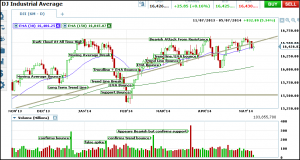
Reading Charts – Closing Guide
In that location are many candlestick patterns for y'all to explore if you bask this blazon of "visual" trading style, I've barely scratched the surface. Candlestick patterns are useful for both short and long-term trades every bit these patterns occur on i minute charts right up to weekly charts (or longer). Looking at a chart y'all'll see lots of patterns, the key is to understand which ones are really signals and which ones are but random market movements. Be selective, and only trade when there are confirming factors and indicators. Use other technical analysis methods to validate all patterns. For example, a bullish engulfing pattern that occurs at a support level is more than likely to piece of work out than if a bullish engulfing blueprint occurs on its own
Candlestick Analysis Course For Binary Options,
Source: https://www.binaryoptions.net/candlestick
Posted by: adamence1987.blogspot.com


0 Response to "Candlestick Analysis Course For Binary Options"
Post a Comment